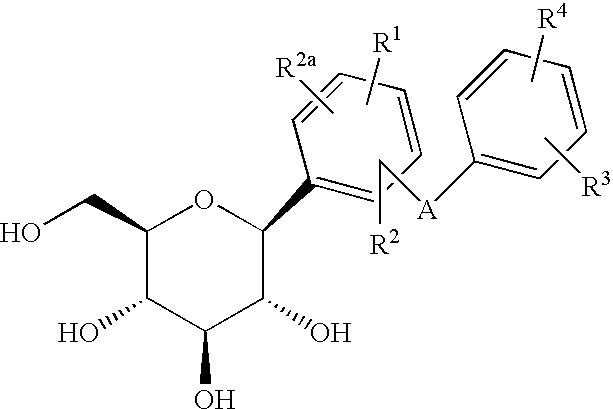C-aryl glucoside SGLT2 inhibitors and method
a technology of c-aryl glucoside and inhibitor, which is applied in the field of caryl glucosides, can solve the problems of unattractive phlorizin itself as an oral solution, undesirable concurrent inhibition of glucose transporter (glut), and inhibition of sglt1 could have serious adverse effects
- Summary
- Abstract
- Description
- Claims
- Application Information
AI Technical Summary
Problems solved by technology
Method used
Image
Examples
example 1
[0230]
[0231]A. 3-Bromo-4′-ethylbenzylhydrol
[0232]Dry Mg turnings (4.4 g, 0.178 mol) under Ar were stirred overnight whereupon 100 mL of dry Et2O was added followed by addition over 1 hr of p-bromoethylbenzene (22 g, 0.119 mol) in 20 mL of Et2O. (In the event the reaction did not start, 0.5 ml of 1,2-dibromoethane was added). After stirring overnight, m-bromobenzaldehyde (11 g, 0.06 mol) in 20 mL of Et2O was slowly added. The resulting light solution was monitored by HPLC over 4-6 hr to determine when complete. The reaction, after quenching with saturated aq. NH4Cl, was extracted 3× with EtOAc. The combined organic layers were washed with brine, dried over Na2SO4 and concentrated using a rotary evaporator. The resulting yellow oil was chromatographed on silica gel using 5% EtOAc / hexane to elute nonpolar impurities and 7-9% EtOAc / hexane to elute 12.4 g (71%) of 3-bromo-4′(ethylbenzhydrol as a light yellow oil.
[0233]B. 3-Bromo-4′-ethyldiphenylmethane
[0234]To a stirred −30° solution of ...
example 2
[0239]
[0240]A. 3-Bromo-4′-methoxybenzhydrol
[0241]To a stirred −78° solution of m-dibromobenzene (70.9 g, 0.3 mol) in 200 mL of dry THF under Ar was added 117 mL of 2.56 M n-BuLi (0.3 mol) in hexane over 10 min. After 30 min, p-methoxybenzaldehyde (27.2 g, 0.02 mol) in 50 mL of THF was added over 20 min. The solution was stirred for 1 hr at −78° (complete by tlc) prior to quenching with saturated aq. NH4Cl. After warming to 20°, the reaction was diluted 2 fold with EtOAc prior to washing with H2O followed by brine. After drying over Na2SO4 and concentration using a rotary evaporator, 103 g of 3-bromo-4′-methoxybenzhydrol was obtained as a yellow oil that was carried forward without further purification.
[0242]B. 3-Bromo-4′-methoxydiphenylmethane
[0243]To a stirred −40° solution of crude Part A 3-bromo-4′-methoxybenzhydrol (103 g, 0.2 mol) in 300 mL of MeCN was added Et3SiH (64 mL, 0.4 mol) followed by BF3·Et2O (27.7 g, 0.2 mol). When complete by tlc, the reaction was quenched by additi...
example 3
[0248]
[0249]To a stirred −78° solution of m-dibromobenzene (12.6 g, 53 mmol) in 50 mL of dry THF under Ar was added 20 mL of 2.56 M n-BuLi (51 mmol) in hexane over 10 min. After 40 min, 2,3,4,6-tetra-O-benzyl-β-D-glucolactone (12 g, 22 mmol) in 30 mL of THF was added over 15 min. The solution was stirred for 1 hr at −78° (complete by tlc) prior to quenching with saturated aq. NH4Cl (40 mL). After warming to 20°, the reaction was diluted 2 fold with EtOAc prior to washing with H2O followed by brine. After drying over Na2SO4 and concentration using a rotary evaporator, 20 g of crude title lactol was obtained as an oil that was carried forward without further purification.
[0250]To a stirred −45° solution of crude Part A lactol (20 g, 0.2 mol) in 60 mL of MeCN was added Et3SiH (7.8 mL, 45 mmol) followed by slow addition over 20 min of BF3·Et2O (4.2 mL, 22 mmol). When complete by tlc after an hour, the reaction was quenched by addition of saturated aq. K2CO3 (25 mL) and the mixture was ...
PUM
| Property | Measurement | Unit |
|---|---|---|
| Electrical conductance | aaaaa | aaaaa |
| Electrical conductance | aaaaa | aaaaa |
| Electrical conductance | aaaaa | aaaaa |
Abstract
Description
Claims
Application Information
 Login to View More
Login to View More - R&D
- Intellectual Property
- Life Sciences
- Materials
- Tech Scout
- Unparalleled Data Quality
- Higher Quality Content
- 60% Fewer Hallucinations
Browse by: Latest US Patents, China's latest patents, Technical Efficacy Thesaurus, Application Domain, Technology Topic, Popular Technical Reports.
© 2025 PatSnap. All rights reserved.Legal|Privacy policy|Modern Slavery Act Transparency Statement|Sitemap|About US| Contact US: help@patsnap.com



